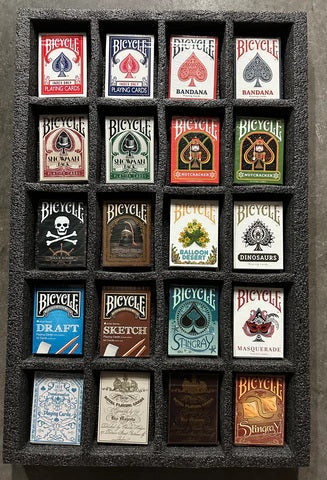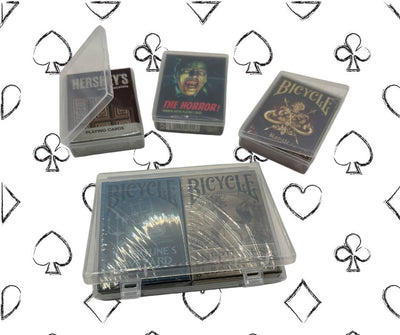Number of Cards
Why do decks of playing cards have 52 cards? It turns out that that this is the number of cards they have always had, at least dating back as far back as we can go based on evidence from their earliest days in Europe. Playing cards are first documented as appearing on the European continent in the 14th century. Although Spanish decks would later be reduced in size to a 40 card deck, and different sized decks have become standard in some parts of Europe due to regional variances and influences, the original Italian decks did consist of 52 cards in four different suits, much like today's deck of playing cards.We can't be certain what exactly accounts for this number of cards, although there is a long tradition that connects the four suits with the four seasons, and the 52 cards with the number of weeks in a year. With this explanation, the 12 court cards are connected with the number of months in a year, while the 13 cards in each suit are seen to correspond to the months in a traditional lunar year, and the number of weeks in each season. Even if this explanation doesn't account for the origin behind the make-up of today's deck, it certainly adds something interesting to its significance!
Ranking of the Ace
The King was long considered the highest valued card in the deck. So why is it that today the Ace is considered the top dog in many card games?The special significance of the Aces in some regions may have its roots in the French Revolution in the 18th century. At this time the traditional court cards of Kings, Queens, and Jacks were replaced with Liberties, Equalities and Fraternities. After all, any revolutionary worth his salt wouldn't want to play with royal characters!
With the arrival of Napoleon in the early 1800s, the Kings, Queens, and Jacks made their return, but it's entirely possible that the rising of the Ace as a symbol of the lower class dominating the royalty may be traced to this revolutionary period in French history. We can't be definitive about this however, because there are also some instances as early as the late 14th century of the Ace being treated as the highest card.
Court Cards
The court cards have always had a variety of artistic designs. Early court cards had no queens, reflecting the male domination that was common in the royal courts of Europe at the time. Modern Italian, Spanish, and German decks still continue this tradition today. The French however did include a female in their set of royal courts, perhaps as a reflection of French gallantry and chivalry. In the late 1500s there was even a trend among French producers to assign famous literary characters to specific court cards, such as David, Alexander, Charlemagne, and Caesar for the Kings. Different regions reflected their own preferences and interests, and while the original Italian cards used a King, Queen, and Knave, the Spanish replaced the Queen with a Knight, and the German deck similarly had two Knaves (upper and lower) as the two companions of the King.Varying cultural and domestic influences shows a rich variation in the court cards used in different geographical areas, and there was still an enormous diversity in designs of the court cards. But all that changed with the success of Londoner Thomas de la Rue, who first was granted Royal Letters Patent for printing playing cards by letterpress and lithography in 1832. Prices and taxes dropped, output and consumption increased, and the mass production that resulted from this saw the smaller workshops of designers disappear. Under de la Rue, cards became standardized. From this time onwards, new designs have always been considered temporary novelties, and serious card players have always opted to revert back to the traditional designs popularized by de la Rue, and later modernized and adjusted by Charles Goodall into a form very close to a typical Bicycle deck we use today.
Today these designs are still the standard for playing cards. The King of Hearts is typically considered the "suicide king", since he is pictured with a sword in his head. Other interesting details include the fact that the King of Hearts is the only king without a moustache, while the King of Diamonds is called "the man with the axe" since he is the only king carrying an axe instead of a sword. The Queen of Spades is often called the "black lady" or even the "bedpost queen", while the Queen of Clubs is known as the "flower queen" since she is depicted holding a flower. The Jacks were originally called Knaves, referring to royal servants, but this was changed to Jacks because the use of Kn in the index caused confusion with the K of the Kings. The Jack of Diamonds is sometimes denoted "laughing boy".
Double-ended Courts
For a long time, court cards were depicted with a distinct one-way or full-length design, with the entire canvas of the playing card used to depict a full-sized character.Double-ended court cards do exist from the 1600s, but it was only around 1865-70 that these became standard. The invention is usually attributed to a French card maker as early as 1745. However it was only in a later time that the French government allowed these double-ended designs to be printed.
Perhaps the most important factor that led to their acceptance and popularity, was that otherwise court cards in your hand might be accidentally revealed to an opponent, i.e. if you turned them around while sorting them in your hand, you were making it obvious that you held a court card.
Ace of Spades
The Ace of Spades is considered the signature playing card in a deck. Even in a deck with minimal customization, you can expect to see something special from the court cards, the Jokers, and the Ace of Spades, which typically has an elaborate design along with copyright information or the name of the manufacturer. But why?As it turns out, this practice dates back to the production of playing cards in England in the early 18th century, and has its roots in the methods used to ensure that taxation was paid. Given how popular playing cards were, it was no surprise that those in government realized the potential for this to become a lucrative form of revenue by means of taxes. English Parliament passed an Act in 1710 which required that cards were not to be removed from the "House or place of Making" until they had a seal on the package, indicating that the tax had been paid. This Act was amended the following year, and required that "one of the Cards of each pack or Parcel ... shall be also Marked or Stamped on the Spotted or Painted side thereof." As fate would have it, the Commissioners for Stamp Duties soon settled on the Ace of Spades as being the "duty card", probably because it was typically the top card in a deck, although this choice was only formalized by law in 1765.
Initially, this duty was stamped by hand on the Ace of Spades. But for the period 1828 to 1862, specially printed Aces of Spades were produced. The tax was initially 1 shilling per gross packs, while foreign packs were taxed at 2 shillings per gross packs. The amount of taxes slowly crept up, which eventually led to tax evasion. In 1805, one man was even condemned to the death penalty for forging an Ace of Spades! Perhaps this is why the Ace of Spades is sometimes called the "Death card". But it was due to problems like this, that the tax was reduced again to 1 shilling in 1828, and the decision was made to produce the officially printed Aces of Spades instead of using the hand stamping method.
As part of the requirements of this new provision, every maker was required to register "a print, stamp or mark of his own name or invention", so that the makers of the cards could be identified. The Perkins Bacon company was responsible for printing these duty Aces on behalf of the Commissioner for Stamp Duties. A great variety of marks were used, and this rich variety was magnified by the fact that a single manufacturer could use a number of different marks if they wished. These Aces were often ornate and surrounded with intricate details, such as a royal crest, or animals like a lion or unicorn, and had the kind of ornate details that are reminiscent of banknotes. During this period (1828-1862), these Aces were often referred to as "Old Frizzle".
1862 is the date that the duty ace was abolished, since the tax was reduced further to three pence and now instead indicated on officially printed tax wrappers. But many makers of playing cards continued the familiar custom of printing their names on the Ace of Spades anyway. England finally abolished the duty and tax wrappers altogether in 1960, when it was no longer worth the trouble of collecting the tax. But the fate of the signature Ace of Spades had been decided, and to this day it is the one card in a deck that typically gets special treatment and elaborate designs. Once again, history has played a leading role in giving the Ace of Spades its long enjoyed position of prominence!
Indices
Early playing cards didn't have any indices. These are an American innovation, and were in part a result of the popularity of Poker and other gambling games. The presence of indices enabled a poker player to tightly hold his hand, fanning the cards slightly and yet identify their values. Cards with indices were first called "squeezers", and were introduced in the 1870s by the New York Consolidated Card Company. The idea may have originated with early nineteenth-century Spanish cards, some of which also have an index in the top right corner.But not everyone liked the idea, and another well known card manufacturer, Andrew Dougherty and Company, tried to compete with this innovation by introducing the idea of "triplicates", which had miniature card faces in the opposite corners, with the intention that these be used for the same purpose. But indices as we know them today won over the day, so the triplicate concept didn't last long, and today indices are a standard feature of playing cards.
The popularization of indices was also responsible for the name change of the third court card from Knave to Jack, since the originally used abbreviations of K, Q and Kn for the court cards was potentially confusing, and it became necessary to use a designation that didn't repeat the use of the letter K.
Jokers
The Jokers were never originally part of playing cards, and are another addition to our deck that we owe to influences from the United States. It was first called the "best bower", which will be a familiar term for those who know how to play euchre. The Best Bower refers to the highest trump, and is considered to be the highest valued card in the game. Euchre gained popularity during the mid 1850s, and the word Joker may even be derived from a variant of the word euchre, or even as a corruption from the German word "bauer" or "boer". In Euchre, the highest card (right bower) is the Jack of the trump suit, and the second-highest trump (left bower) is the Jack of the same coloured suit. From around 1860, the Joker was intended to function as the third and highest trump, and was also called the "imperial trump".
But the Joker slowly snuck into some other games besides euchre. The first evidence of the Joker ever being used as a wild card is in connection with a poker game dates from around 1875. The practice of depicting the Joker with artwork in the style of a jester or fool apparently began after the Joker arrived in Europe.
About the writer: EndersGame is a well-known and highly respected reviewer of board games and playing cards. He loves card games, card magic, cardistry, and card collecting, and has reviewed several hundred boardgames and hundreds of different decks of playing cards. You can see a complete list of his game reviews here, and his playing card reviews here. He is considered an authority on playing cards and has written extensively about their design, history, and function, and has many contacts within the playing card and board game industries. You can view his previous articles about playing cards here. In his spare time he also volunteers with local youth to teach them the art of cardistry and card magic.





